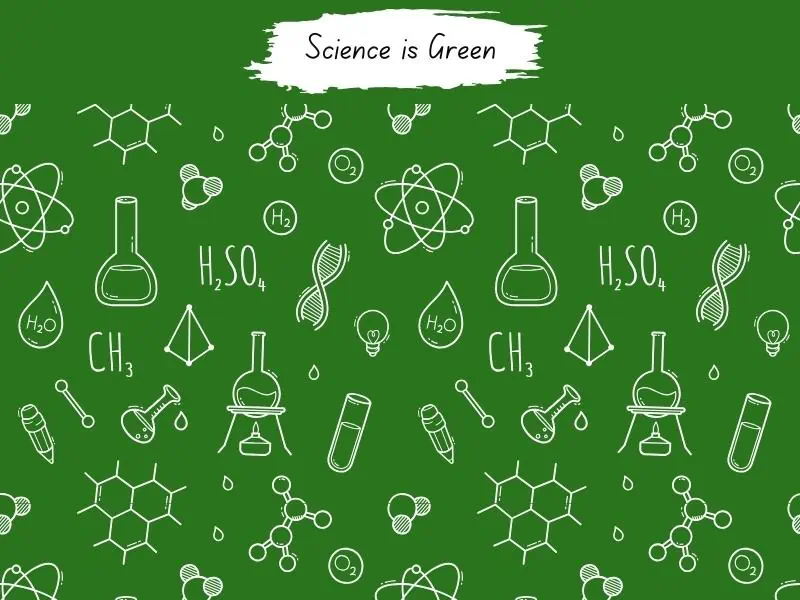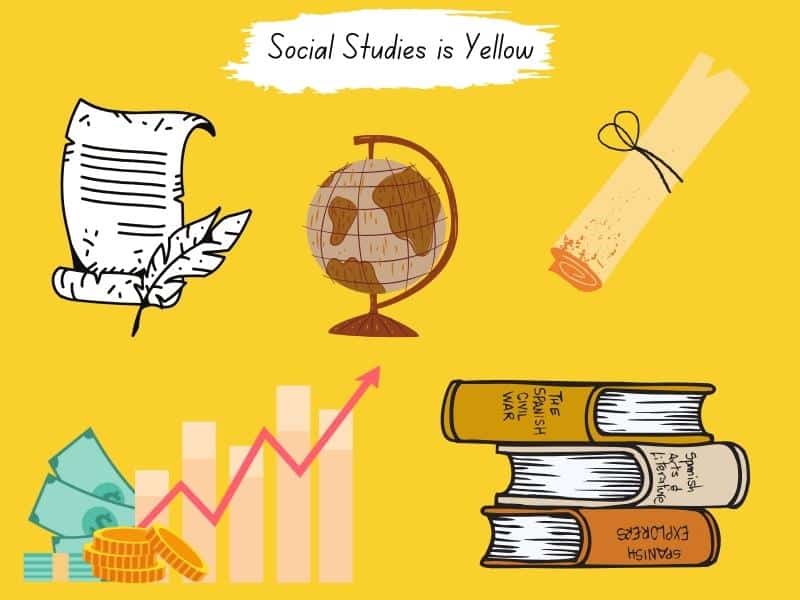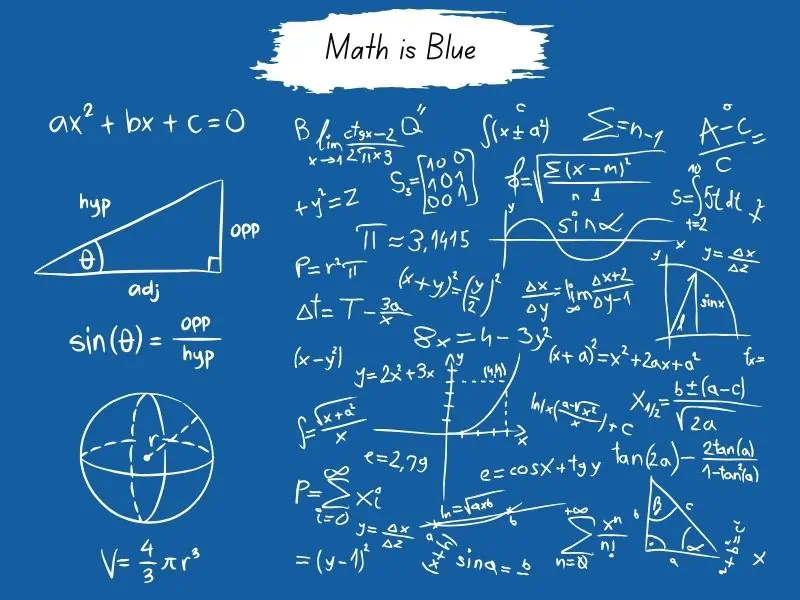What color is science, math, or English? Today, you’ll find out why science is green, math is blue, and English is red.
School subject colors have become a trending topic. Thus, more and more students and even adults are becoming interested in which colors are associated with which school subjects.
Science, math, English, and social studies are the most discussed classes.
Interestingly, adults are curious even if they finished school long ago. The reason is that each of these colors has different meanings.
What are School Subject Colors?
The colors of school subjects differ from subject to subject and are usually associated with school classes.
For example, red, green, blue, and yellow are associated with mathematics, science, social studies, and English.
Some people match colors with electives, such as art or foreign language – which is often English.
This association of school subjects with colors comes subconsciously. The reason is not yet clear, but symbolism and their meanings play an important role.
However, the subject colors are very subjective and can differ from person to person, depending on how well they have mastered that subject.
For example, if you’re good at math, you’ll associate it with blue. Otherwise, the first color that comes to mind is red.
Why Do We Associate School Subjects With Colors?
When it comes to school subjects, it’s interesting how we often find ourselves associating them with specific colors that reflect their essence, characteristics, and especially the feelings they evoke.
One of the primary reasons for associating school subjects with colors is the way our brains naturally process information.
Colors have a powerful effect on emotions, memory, and the way we perceive things. When we study or engage with different subjects, our minds form connections between the subject matter and the colors associated with them.
This creates a sensory and emotional link that enhances our understanding and retention of the material.
Another reason we associate colors with subjects is that they provide a visual representation that can simplify complex concepts.
Colors have been assigned to school subjects to help us keep track of them. As a result, as students, we used color-coded folders for both notes and assignments.
This association has become so ingrained in the minds of some people that we still make the same associations today.
For example, mathematics, often represented by the color blue, is associated with logic and precision.
Blue’s calm and organized personality complements the structured approach required to solve mathematical problems.
But mathematics can also be associated with red because it is perceived as an exciting color that maintains attention and stimulates cognitive participation.
So, the association is subjective and depends on how much you liked that subject and also on the teacher who taught it.
Cultural and psychological factors also play an essential role in these associations. Specific colors have established meanings and connotations in various cultures.
For instance, red might be associated with energy, passion, or caution, depending on the context.
Colors can also trigger certain emotions and moods from a psychological standpoint.
Warm colors, such as red and orange, are energizing, whereas cool colors, such as blue and green, can be soothing.
So, if we like a subject, we associate it with a color that makes us happy and excited, such as yellow. Suppose the subject isn’t one of our favorites. In that case, we’ll label it as red because this color is associated with anger.
Which School Subjects are Which Colors?
From the logical world of mathematics to the creativity of English, the exploration of history in social studies, and the wonders of science, each subject has its own hue that resonates with students.
What Color is Science?

What color is science? The short answer is green. This is because green is associated with nature, life, rebirth, and Earth in general.
Science includes geography, biology, chemistry, and physics classes.
What color, for example, would be more appropriate for geography than green? Geography is a spatial science that studies the Earth in all its aspects. However, geography can also be considered a social science.
Green Meaning
Green symbolizes harmony, growth, and renewal. It is the color of nature and health, resonating perfectly with science.
Furthermore, this color represents balance and equilibrium.
What Color is Social Studies?

Social studies function as a field of study that incorporates history, geography, sociology, and economics. So, social studies is not a subject.
Social studies is yellow because it takes us back to history, and every vintage stuff has a yellow tint. Moreover, yellow is associated with knowledge and curiosity.
Although some suggest that red or blue would be more appropriate for social studies, this association comes more from the color-coded folders used in school.
Yellow Meaning
Yellow symbolizes happiness and optimism. In addition, this color is often associated with knowledge, enlightenment, and curiosity.
Just as sunlight illuminates the world and brings clarity, social studies serves as a beacon that sheds light on historical events, cultures, and societal interactions.
Yellow also sparks curiosity about the complexities of human societies and their evolution.
What Color is English?

English is red because it’s a subject that embodies passion, energy, and intense emotion, like the color itself.
These qualities draw an interesting parallel to the realm of English. As a form of expression, language often conveys deep emotions and thought-provoking ideas.
Although red and blue are frequently used for math and English, red is more appropriate for English.
English is red because it is a much more emotional subject than math. Moreover, red is associated with intense emotions such as passion or even anger.
English, on the other hand, can be blue because it gives us freedom, specifically the freedom to express ourselves and be understood in any part of the world.
Red Meaning
Red represents passion, energy, and emotion. It is associated with strong emotions, just like English.
But red is also about motivation and action – two important factors when creating an excellent writing project.
Furthermore, passion is essential in learning English.
Red is also beneficial to learning and is one of the most popular colors among students because it draws attention, maintains focus, and can stimulate active participation.
What Color is Math?

Math and English are two subjects whose associated colors have sparked controversy.
Math is blue because it is a technical, cold, emotionless subject. Moreover, this color reflects the logical and structured nature of math.
Mathematics is not subjective because it relates to logic and facts.
Math is a subject that requires precision, problem-solving, and systematic thinking. Just as blue provides clarity, mathematics provides a framework for understanding equations and complex calculations.
Blue Meaning
Blue is related to patience and understanding. It also symbolizes wisdom, trust, and reliability. These qualities are essential in understanding mathematics, whether it is algebra or geometry.
Blue is often seen as a color that symbolizes logic, calmness, and precision. Blue, like mathematics, leaves no room for interpretation, being loyal and trustworthy once mastered.
Blue, with its calming and organized nature, represents the rationality and clarity that are essential in the world of math.
Blue also represents innovation, and there is no innovation without math.
Other Subject Colors
Other subjects or electives are also associated with specific colors, similar to how English and math are related to red and blue.
Art can be associated with a diverse palette of colors. They could span from vibrant yellows representing inspiration to calming blues symbolizing artistic reflection. Art is, therefore, more of a gradient than a color.
Language arts, including literature and writing, could be embodied by purple. Purple, the color of royalty, is linked to creativity and imagination.
Biology, the study of life and living organisms finds its color in green. Green, symbolizing growth and renewal, aligns perfectly with the subject’s exploration of ecosystems’ evolution of all living things.
Chemistry could be represented by the color orange. Orange reflects curiosity and exploration, mirroring the exciting experiments and discoveries within the world of chemicals and reactions.
Music, a symphony of notes and rhythms, can be embodied by gold. Gold symbolizes achievement and excellence, aligning with the dedication and skill required to master the art of music and create harmonious compositions.
Philosophy, the study of fundamental questions about reality, existence, and ethics, embodies the qualities of the color black. This color is related to depth, contemplation, and exploring the unknown.
But black is also about elegance, sophistication, power, and formality. That’s why business and technology classes can also be linked to black.
Last Words on the School Subject Colors
Colors are associated with subjects, but they are highly subjective. As a result, there is no correct or incorrect answer.
This is because some people form these associations based on the feelings evoked by the subject, whereas others associate them with personal experiences and preferences in school.
So, what are the colors of school subjects? Science is green, math is blue, English is red, and social studies is yellow. In addition, music is gold, and technology is black.
Did you enjoy this article about the subject colors? Help us spread the word and share it with your friends.

